Beautiful crafts, made independently, attract attention not only with the originality of shape, color, but also the material used. Focusing on the proposed master classes, you can make unusual jewelry from knitting threads. Children are often involved in such activities that develop creative thinking.
Pictures from threads
Crafts made from knitting threads do not require the use of complex technological methods and devices. With the help of additional available materials, you can even make paintings, thinking through their color scheme, harmonizing with the overall style of the interior.
Thread applique
Don't throw away even small pieces of yarn. It should be collected immediately in separate bags. Then these scraps will serve as excellent material for a colorful picture.
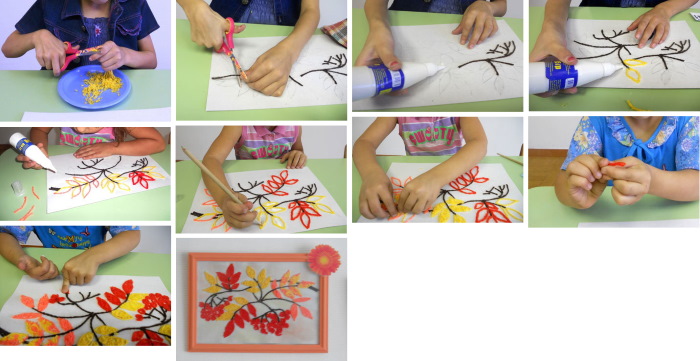
List of materials:
- yarn scraps for knitting;
- PVA glue;
- cardboard;
- scissors.
Algorithm of actions:
- The outline of the future image is drawn on a sheet of cardboard with clear lines. A color sketch of it should be on a separate sheet of paper for reference.
- The yarn of the required shades is cut with scissors into tiny pieces resembling cotton wool.
- Lubricate the element of the drawing generously with glue. Sprinkle it with thread scraps of a suitable color, covering the background completely.
- Press gently to ensure complete adhesion.
- The entire composition is designed consistently.
When the glue dries, carefully turn it over to shake off excess threads. Frame it and place it in the interior, choosing a suitable place.
Modern abstraction
Painting in the proposed technique requires attention. Work with paint is carried out only by adults. It is necessary to provide protective equipment - glasses, gloves. The room must be well ventilated. If possible, go outside.

List of materials:
- a rectangular tablet made of smooth cardboard or plywood with canvas stretched over it;
- strong thick thread;
- spray paint;
- scotch.
Algorithm of actions:
- One end of the thread is fixed with tape approximately in the center of the tablet on the back side.
- The yarn is wound in a random order onto the tablet, forming a pattern of the required degree of openwork on its front side.
- For reliability, the laid rows are glued with tape from the inside.
- Paint is sprayed from a can.
- When the work is dry, the threads are removed.
The finished work can be framed if desired. One tone of paint is used or a multi-colored picture is created. Depending on the idea, the shades can be contrasting or have a harmonious sound.
Picture of intertwined threads
A fascinating image can be obtained from an ordinary thread. The technique is simple, but requires the ability to handle a hammer. With the right choice of color, the picture will become the highlight of the interior.

List of materials:
- knitting threads of medium thickness;
- wooden square or rectangular tablet;
- nails with decorative heads (you can use pushpins);
- hammer.
Algorithm of actions:
- Paint the tablet, choosing black, silver, gold or neutral gray for the background of the painting.
- When the workpiece dries, draw straight lines, stepping back from the edge by about 2.5-3 cm.
- Nails are driven in along the marked line (buttons are attached). The interval between them is calculated depending on the predicted openwork of the future image. On average, this figure is 2-3.5 cm.
- Tie the end of the thread to one of the corner nails.
- Pull it diagonally, securing it with a knot on the opposite nail.
- Each nail is wrapped in a similar manner, ensuring that the intersection of the yarn falls exactly in the center of the composition.
The finished work is placed in the chosen place. It can be hung on the wall, placed on a cabinet or on a shelf.
Flowers
Crafts made from knitting threads in the shape of flowers will appeal to people who are fond of needlework, since they usually have a large number of small scraps of yarn left over.
Even small items made from them will add a bright touch to the interior of the room.
Flowers on a fork
Fluffy buds of different shades are easy to make at home even for a child over 6 years old. It is important to explain safety precautions to him beforehand.
List of materials:
- fork;
- knitting threads, which can be of medium thickness, smooth, and also slightly fluffy, of a rich or delicate pastel shade;
- wire wrapped in green yarn (you can buy chenille hairy wire of the corresponding shade);
- scissors.
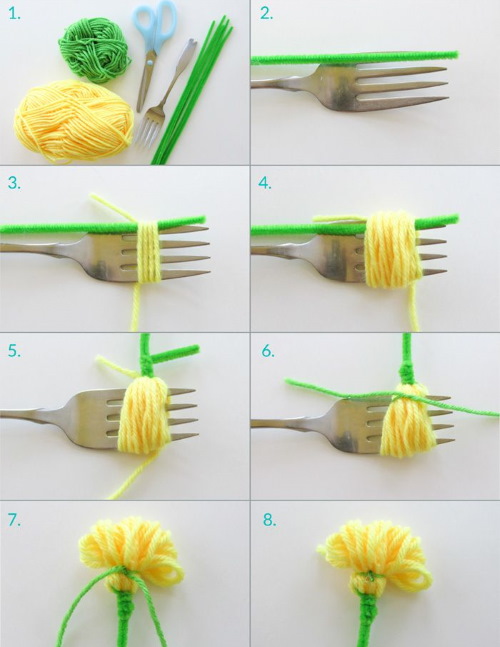
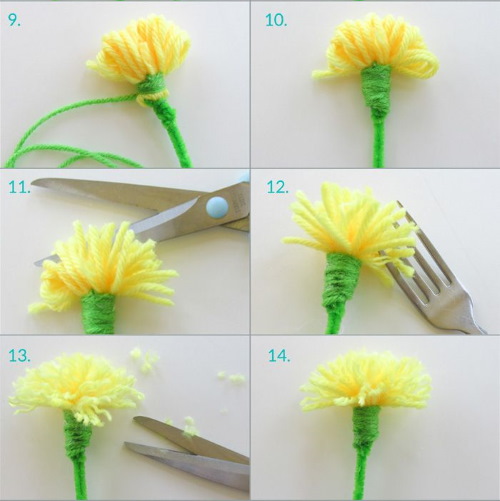
Algorithm of actions:
- Cut off a piece of wire, which will act as the stem and future leaf, 3 times longer than the size of a similar fork.
- Place a piece of wire on the side of the fork so that the upper end rises 50-60 mm above the teeth.
- Start winding the fork tines with yarn in the transverse direction along with the wire. Make several not very tight turns so that the ball on the fork ends up being fluffy.
- Cut off the working end of the thread.
- The upper free end of the wire is bent and twisted at the bottom of the ball around the stem, securely fixing the bud.
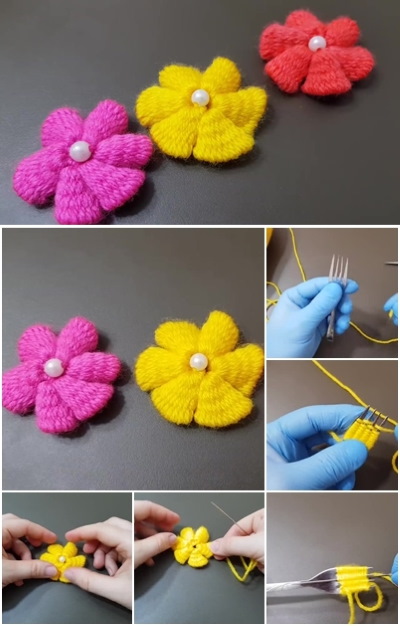
- Remove the flower and carefully cut all the upper folds to get a lush bud. You can trim it slightly.
- The lower end of the wire is bent upward.
- They form a leaf out of it and twist the tip at the bottom of the stem.
You can make a whole bouquet by choosing yarn of one color or different shades. The role of the vase will be played by a jar, which is tightly wrapped with yarn in the tone of the main composition. The ends of the threads are fixed with glue or sewn.
Animals
Crafts in the form of animals from knitting threads without a hook and knitting needles can be made with your own hands, using the suggested master classes.
The yarn is selected in the required shade, taking into account the characteristics of the character being made.
Rat made of threads
The ability to make a rat yourself is becoming relevant, given that it is now the year whose symbol is this rodent. It is advisable to choose a shade of thread white with a metallic sheen, which will fully correspond to the eastern calendar.
List of materials:
- wine bottle cork;
- copper wire with a diameter of 15 mm - 52 cm;
- white thread (preferably with a silver sheen);
- thin jute cord for the base;
- knife;
- 3 pins with ball-shaped tips for nose and eyes.
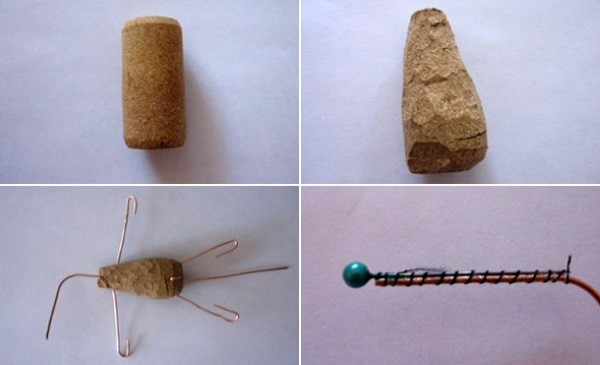

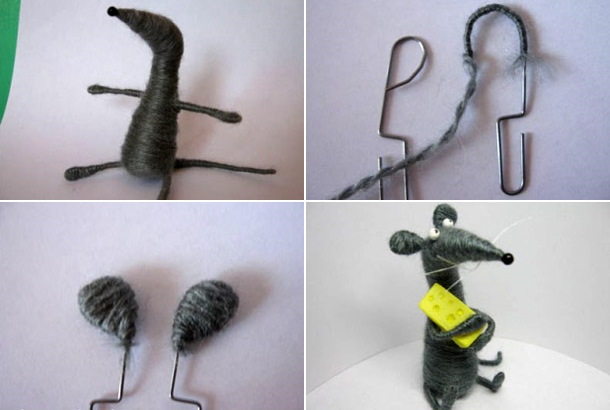
Algorithm of actions:
- The cork is slightly cut into a cone at the top end. The bottom section is rounded, giving it the shape of the body.
- Copper wire without insulation is cut into 6 pieces 10 cm long (for arms, legs, ears). You will also need 2 pieces 6 cm long (for the neck with head and tail).
- The longer wire parts are used to pierce the plug in the pelvic and shoulder areas.
- Shorter pieces of wire are fixed in the area of the tail and neck.
- A pin is tightly applied to the upper end of the wire so that the ball protrudes beyond the workpiece. Tie with a thread.
- The wire is covered with glue. They begin to wrap it with jute cord, forming the head and neck of the animal.
- Using a similar technique, after applying glue to the base, the limbs are wrapped with the main white yarn, first in one layer.
- The ends of the resulting leg and arm blanks are bent into loops, forming palms and feet.
- Again, glue is applied on top of the threads and the arms and legs are given the required shape by wrapping them with yarn.
- After wrapping the tail with a white thread in one layer, the tip is fixed with glue. There is no need to bend it.
- Now the glue is spread over the cork body and the jute cord is wound, giving it the desired shape, taking into account that more turns will need to be made in the pelvic area.
- It remains to give the desired color. The base is gradually coated with glue and, starting from the nose, the entire base of the head, neck and body is wrapped in tight coils.
- For the ears, wrap half of a 10 cm long piece of wire with white thread in one layer. Then wrap it into a circle, leaving a 5 cm long stem free of yarn.
- Wrap the ears tightly with the main yarn, not forgetting to coat the base with glue.
- The ear legs are coated with glue and stuck into place.
- The pin heads for the eyes are painted white and black pupils are drawn. Glue is applied to the legs and fixed to the head.
- For the antennae, a thin fishing line is threaded through a needle and stitched across the head several times.
A piece of cheese for a rat can be cut out of yellowish or white eraser. It is convenient to make holes using a metal dowel. Clamp it with pliers, heat it over a gas burner flame and press it in several places to the piece. Thanks to the wire base, the rodent securely clamps the cheese with its paws.
Home decorations
Crafts made from knitting threads serve as original decorations that can diversify the decor of your home.
By following the specified sequence of actions, you can easily create exclusive items.
Openwork lampshade
Work on making an airy openwork lampshade begins with selecting threads that match the tone of the main style of the room. This approach will allow you to easily fit the product into the surrounding entourage without violating the visual perception of its integrity.
List of materials:
- cotton threads (No. 10);
- scissors;
- a balloon, the shape and size of which, after filling with air, should correspond to the future lampshade;
- PVA glue in a plastic bottle;
- cartridge with cord;
- energy saving LED light bulb.
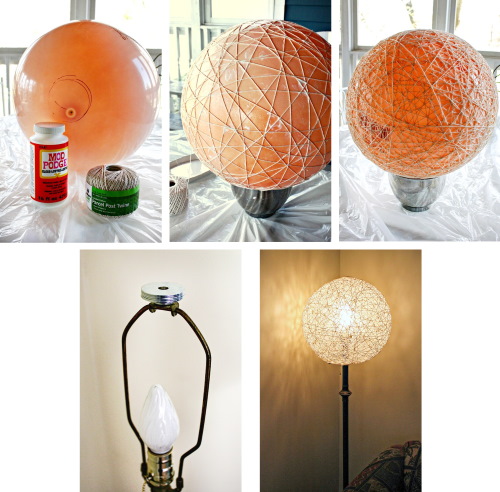
Algorithm of actions:
- Inflate the balloon. Tie the hole tightly.
- Apply a generous, even layer of glue over the entire surface of the ball.
- They wrap it with threads, making a fairly tight weave.
- Leave for 24 hours to allow the glue to dry completely.
- The air is released from the balloon and removed from the openwork thread blank.
A hole is carefully cut out at the bottom, and then the socket is fixed. Do not use heating bulbs, which can deform the lampshade due to the heat emitted. The best option is LED bulbs.
Wall tree
An original wall decor is obtained if a tree is made from threads on a single-color surface. You can use yarn of one tone. If desired, the crown is made in green.

List of materials:
- medium-thick yarn of the desired shade (brown is often used for the trunk and branches);
- chalk;
- carnations.
If the wall is concrete, which does not allow hammering in a sufficiently large number of nails, the composition is made on a large sheet of plywood.
Algorithm of actions:
- On the plane allocated for the composition, the main outline of the tree is drawn with chalk.
- Nails are driven in along the marked lines (they can be replaced with pins).
- Starting from the bottom, wrap the nails with threads. Make several turns for reliability.
The yarn is directed chaotically, imitating the unevenness of tree bark. With a voluminous composition, you have to spend quite a lot of time, but the end result will please you with an unusual look.
dream Catcher
An amazing talisman, which received the figurative name "dream catcher", according to Indian beliefs, protects a person's spirit from evil spirits at night. Nightmarish dreams do not disturb the sleeper, as they get entangled in the web. Pleasant dreams penetrate unhindered. Such a talisman can be made with your own hands if desired.
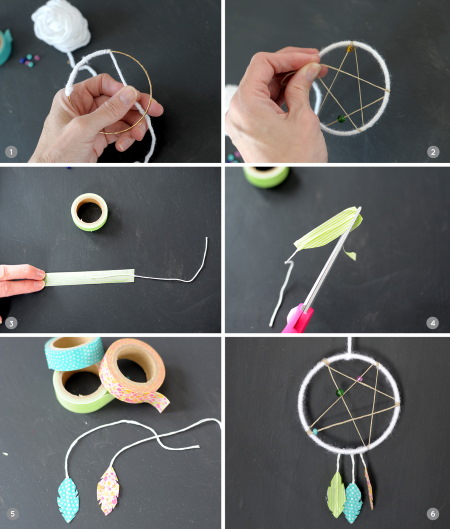
List of materials:
- yarn of red and brown tones;
- brown wooden beads;
- hoop - an internal part without clamps (you can use a ring cut out of plywood or wood);
- scissors;
- red feathers.
Algorithm of actions:
- The entire ring is wrapped in tight turns of brown yarn. A thread end of up to 15 cm is left for the future hanger.
- The inner space of the ring is braided with red yarn like a spider web. For the first row, the thread is tied at intervals of 3-3.5 cm. For the second row, the loops are fixed in the center of the free thread of the first. Beads are strung in the second and sixth rows.
- When the web is ready, cut off 3 brown threads. Make the length 12-15 cm.
- One section is fixed under the hanger. The other 2 threads are tied on both sides, leaving 2.5-3.5 cm.
- A bead is put on the end of each thread. The tip of the feather is threaded through its hole and tied with the remaining piece of yarn.
To cleanse, keep the dreamcatcher outdoors in the sun for 5-6 hours. Then place the amulet near the bed. Don't forget to clean it in the fresh air once a month.
Neck decoration
Crafts made from knitting threads can be small in size, playing the role of decorations. Even their simple configuration, with careful execution of all operations, allows you to get interesting products that attract attention.


List of materials:
- scissors;
- washers of the required sizes;
- thin cotton threads;
- chain;
- superglue.
Algorithm of actions:
- A long thread, folded in half, is threaded into a loop through the ring. The free ends are inserted into the loop, securing the yarn.
- Wrap the washer with a double thread, making tight, dense turns. Cut and fix the tip with glue on the back of the ring.
- The finished ring is attached to a beautiful chain.
You can make several single-color or multi-colored rings and assemble a more complex necklace. The elements are connected in one row. If desired, several rows are made, placing the braided rings in a checkerboard or random order. They are connected together with yarn of the main or contrasting shade.
Bracelets
Home craftswomen use scraps of knitting threads to make not only beads and necklaces, but also bracelets. You can offer a simple weaving technology to older preschool children.

List of materials:
- cotton threads of medium thickness with a silky sheen - red, emerald, lilac;
- scissors;
- scotch.
Algorithm of actions:
- Cut threads of each color to a length of 100 cm.
- They are folded into one bundle, aligning the edges.
- Bend in half. The loop under which the threads are tied will later serve as a fastener.
- Using scotch tape, the workpiece is fixed to the table by the loop. This technique makes the work easier, since the workpiece will not shift. You can secure it with a pin on a thick cushion with foam padding.
- The threads are laid out in the following order: red, emerald, lilac, and this sequence is repeated again.
- Using the leftmost red thread, tie knots on each segment in turn.
- Then the working thread becomes a piece of emerald color. Knots are also tied with it.
- This weaving continues until the length of the bracelet reaches the desired value.
- To prevent the bracelet from unraveling, make a knot at the end with all the threads.
- Cut off the remaining yarn, leaving 2-3 cm.
The bracelet is put on the wrist. The clasp is a knot that is passed through a loop.
Tips from the masters and recommendations from professionals
When starting an activity, you should review your stock of knitting threads. They can be of different thickness, smooth or fluffy, have a natural or synthetic base.
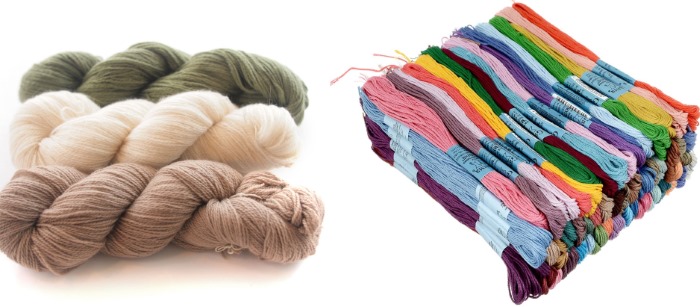
Table. Tips from the masters and recommendations from professionals
| Type of activity | What is recommended to do |
| Systematization of existing thread stocks | All yarn remnants are placed in separate boxes and classified according to one of the indicators - color, fiber type or thickness. |
| Selecting the texture of threads depending on the product | For wall panels, rougher varieties should be used. They hold their shape and do not deform with the inevitable fluctuations in humidity and temperature in the room. |
| Making miniature products | Small decorations require thin, soft, slightly silky cotton threads. |
| Working with tools | When making thread compositions, the usual tools are required - scissors, hammer, needles, pins. If children are involved in the work, safety precautions must be monitored. |
Despite the simple methods of work, crafts made of threads look unexpectedly original and fresh. They use a variety of yarns used by needlewomen for knitting. By following the sequence of actions reflected in the master classes, even in the absence of skills for such activities, you can make an unusual product for interior decoration yourself.
Author: E. Gryzlova
Video about making thread crafts
Crafts from knitting threads:
